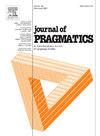Toward a granular analysis of the discourse marker ti: in Tunisian Arabic
IF 1.7
1区 文学
0 LANGUAGE & LINGUISTICS
引用次数: 0
Abstract
This study offers a granular analysis of procedural relevance by challenging the traditional view of discourse markers as performing a fixed procedural function. The analysis draws on a corpus of Tunisian Arabic supported by a speaker survey to examine the pragmatic effects of ti: across diverse communicative contexts. Focusing on the understudied yet pervasive discourse marker ti: in Tunisian Arabic, the paper relies on corpus data and speaker insights to disambiguate its complex functional load. The findings reveal that the frequency of ti: stems from its high degree of multifunctionality: it serves diverse conversational roles, influences the trajectory of interaction, and reflects the dynamics between discourse participants. The paper argues that this multifunctionality is rooted in ti:’s multicategorial status, enabling it to perform multiple communicative tasks across different discourse domains. As such, ti: exemplifies a “multiperformative” discourse marker—an element that simultaneously encodes various pragmatic functions with minimal speech effort. This efficiency points to broader implications for the typology of discourse markers, both in Arabic and crosslinguistically. Ultimately, the study underscores the need for a more nuanced, crosslinguistically grounded model of procedural meaning—one that accounts for multifunctionality, categorical flexibility, and interactional economy. Such an approach, situated within pragmatics, opens the door to productive interfaces with other linguistic fields.
突尼斯阿拉伯语语篇标记语ti的粒度分析
本研究通过挑战语篇标记具有固定程序功能的传统观点,对程序关联进行了细致的分析。该分析利用突尼斯阿拉伯语语料库,并通过对说话者的调查来检验ti:在不同交际语境中的语用效果。本文以突尼斯阿拉伯语中尚未充分研究但普遍存在的话语标记语ti:为研究对象,利用语料库数据和说话者的见解来消除其复杂的功能负荷。研究结果表明,ti:的出现频率源于其高度的多功能性:它服务于不同的会话角色,影响互动轨迹,反映话语参与者之间的动态。本文认为,这种多功能性的根源在于它的多范畴状态,使它能够在不同的话语域执行多种交际任务。因此,它是一个“多行为”话语标记的例证——一个以最小的言语努力同时编码各种语用功能的元素。这种效率指向话语标记的类型学更广泛的含义,无论是在阿拉伯语和跨语言。最后,该研究强调需要一个更细微的、跨语言基础的程序意义模型——一个能够解释多功能、分类灵活性和互动经济性的模型。这种方法位于语用学的范围内,为与其他语言学领域的生产界面打开了大门。
本文章由计算机程序翻译,如有差异,请以英文原文为准。
求助全文
约1分钟内获得全文
求助全文
来源期刊

Journal of Pragmatics
Multiple-
CiteScore
3.90
自引率
18.80%
发文量
219
期刊介绍:
Since 1977, the Journal of Pragmatics has provided a forum for bringing together a wide range of research in pragmatics, including cognitive pragmatics, corpus pragmatics, experimental pragmatics, historical pragmatics, interpersonal pragmatics, multimodal pragmatics, sociopragmatics, theoretical pragmatics and related fields. Our aim is to publish innovative pragmatic scholarship from all perspectives, which contributes to theories of how speakers produce and interpret language in different contexts drawing on attested data from a wide range of languages/cultures in different parts of the world. The Journal of Pragmatics also encourages work that uses attested language data to explore the relationship between pragmatics and neighbouring research areas such as semantics, discourse analysis, conversation analysis and ethnomethodology, interactional linguistics, sociolinguistics, linguistic anthropology, media studies, psychology, sociology, and the philosophy of language. Alongside full-length articles, discussion notes and book reviews, the journal welcomes proposals for high quality special issues in all areas of pragmatics which make a significant contribution to a topical or developing area at the cutting-edge of research.
 求助内容:
求助内容: 应助结果提醒方式:
应助结果提醒方式:


